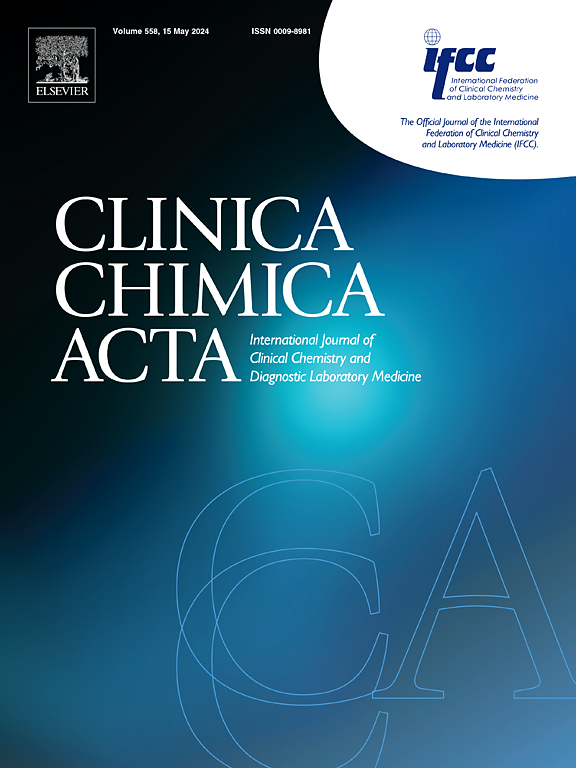急性髓系白血病易感性:白细胞介素37和38遗传变异的影响
IF 2.9
3区 医学
Q2 MEDICAL LABORATORY TECHNOLOGY
引用次数: 0
摘要
白细胞介素(IL)-37和IL-38分别是由IL37和IL1F10基因编码的抗炎细胞因子。最近有研究提出,IL37 (rs3811046 G/T和rs3811047 A/G)的错义单核苷酸多态性(SNPs)和IL1F10 (rs3811050 C/T和rs3811051 T/G)的5′-非翻译区snp可能影响某些炎症疾病的易感性。炎症也被证明在急性髓性白血病(AML)的发病机制中起关键作用。因此,我们有理由推测rs3811046、rs3811047、rs3811050和rs3811051可能在AML易感性中起作用。我们对131名AML患者和169名对照者进行了一项病例对照研究,以调查这些snp与AML风险的关系。采用实时pcr技术TaqMan等位基因鉴别法测定SNP基因型。结果显示,rs3811046、rs3811047和rs3811050的突变等位基因(T、G和T)和相应的纯合基因型(TT、GG和TT)分别与AML风险增加显著相关,而rs3811051没有相关性。四位点单倍型分析(rs3811046-rs3811047-rs3811050-rs3811051)表明,T-A-C-G单倍型与AML风险增加2.47倍相关。SNP-SNP互作分析显示,rs3811046与rs3811047、rs3811046与rs3811050、rs3811047与rs3811050之间存在显著的遗传互作。Rs3811046和rs3811047不影响IL37基因的表达。AML的一些实验室和临床变量可能受到IL37和IL1F10 snp的影响。综上所述,rs3811046、rs3811047和rs3811050在等位基因、基因型和单倍型方面与AML易感性相关,而rs3811051与AML易感性无关。3个snp (rs3811046、rs3811047和rs3811050)表现出显著的基因相互作用。本文章由计算机程序翻译,如有差异,请以英文原文为准。
Susceptibility to acute myeloid leukemia: Influence of genetic variants of interleukins 37 and 38
Interleukin (IL)-37 and IL-38 are anti-inflammatory cytokines encoded by IL37 and IL1F10 genes, respectively. Recently, it has been proposed that missense single nucleotide polymorphisms (SNPs) of IL37 (rs3811046 G/T and rs3811047 A/G) and 5′-untranslated region SNPs of IL1F10 (rs3811050 C/T and rs3811051 T/G) may influence susceptibility to some inflammatory disorders. Inflammation has also been shown to play a key role in pathogenesis of acute myeloid leukemia (AML). Therefore, it is reasonable to hypothesize that rs3811046, rs3811047, rs3811050, and rs3811051 may have a role in susceptibility to AML. A case-control study was conducted on 131 AML patients and 169 controls to investigate the association of these SNPs with AML risk. SNP genotypes were determined using TaqMan allelic discrimination, a real-time PCR-based method. Results revealed that mutant alleles (T, G, and T) and corresponding homozygous genotypes (TT, GG, and TT) of rs3811046, rs3811047, and rs3811050, respectively, were significantly associated with an increased risk of AML, while rs3811051 showed no association. Four-locus haplotype analysis (rs3811046-rs3811047-rs3811050-rs3811051) demonstrated that T-A-C-G haplotype was associated a 2.47-fold increased risk of AML. SNP-SNP interaction analysis showed significant genetic interactions between rs3811046 and rs3811047, rs3811046 and rs3811050, and rs3811047 and rs3811050. Rs3811046 and rs3811047 did not affect IL37 gene expression. Some laboratory and clinical variables of AML may be influenced by IL37 and IL1F10 SNPs. In conclusion, rs3811046, rs3811047, and rs3811050 were associated with AML susceptibility in terms of allele, genotype, and haplotype, while rs3811051 showed no association. Three SNPs (rs3811046, rs3811047, and rs3811050) showed a significant gene-gene interaction.
求助全文
通过发布文献求助,成功后即可免费获取论文全文。
去求助
来源期刊

Clinica Chimica Acta
医学-医学实验技术
CiteScore
10.10
自引率
2.00%
发文量
1268
审稿时长
23 days
期刊介绍:
The Official Journal of the International Federation of Clinical Chemistry and Laboratory Medicine (IFCC)
Clinica Chimica Acta is a high-quality journal which publishes original Research Communications in the field of clinical chemistry and laboratory medicine, defined as the diagnostic application of chemistry, biochemistry, immunochemistry, biochemical aspects of hematology, toxicology, and molecular biology to the study of human disease in body fluids and cells.
The objective of the journal is to publish novel information leading to a better understanding of biological mechanisms of human diseases, their prevention, diagnosis, and patient management. Reports of an applied clinical character are also welcome. Papers concerned with normal metabolic processes or with constituents of normal cells or body fluids, such as reports of experimental or clinical studies in animals, are only considered when they are clearly and directly relevant to human disease. Evaluation of commercial products have a low priority for publication, unless they are novel or represent a technological breakthrough. Studies dealing with effects of drugs and natural products and studies dealing with the redox status in various diseases are not within the journal''s scope. Development and evaluation of novel analytical methodologies where applicable to diagnostic clinical chemistry and laboratory medicine, including point-of-care testing, and topics on laboratory management and informatics will also be considered. Studies focused on emerging diagnostic technologies and (big) data analysis procedures including digitalization, mobile Health, and artificial Intelligence applied to Laboratory Medicine are also of interest.
 求助内容:
求助内容: 应助结果提醒方式:
应助结果提醒方式:


